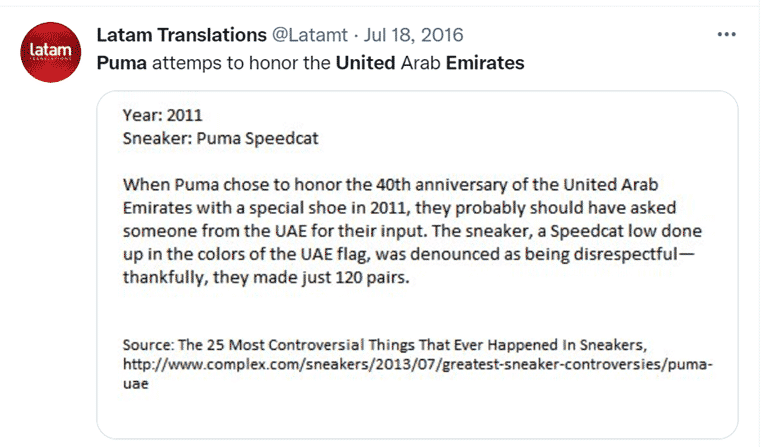The right approach to multilingual marketing strategy
Is your brand lost in translation, missing out on opportunities or revenue? Learn how to correctly do multilingual marketing.
“The customer is always right.”
That business mantra highlights the importance of empathy and understanding the customer’s point of view. It isn’t just an emotional sentiment.
However, the translated version of that phrase doesn’t have the same impact or meaning in different languages and cultures. For example, in France, they say “Le client n’a jamais tort,” which means the “customer is never wrong.” In Spanish and Italian, “El cliente siempre tiene la razón” and “il cliente ha sempre ragione.” are both phrases that translate to “the customer always has a reason.”
In Germany, “der Kunde ist König” it is the “customer is king” and in Japan, “okyakusama wa kamisama desu” (お客様は神様です), the meaning is “the customer is a god.”
Some advertisers believe translating word for word what works in one country will work in another. But people in different cultures, languages and countries think differently. Failing to do your multilingual marketing correctly will lead to missed opportunities and lost revenue.
Let’s consider a popular item, such as an O’Neil tank top. “Tank Tops” sell well enough in North American outlets and online stores. However, sellers need to incorporate the word “vests” to sell more items in the UK. Vest is the preferred term used by consumers living in the UK, which is entirely different from consumers living in the U.S. I have a good friend in the UK who will almost always argue that a vest is a tank top and not a waistcoat.
Just because something works in North America, it can’t always be duplicated in the UK, even if English is the primary language in both areas. Otherwise, O’Neil’s vests risk losing an opportunity and, even worse, the brand alienating itself from the target market.
What follows are five examples of multilingual marketing strategies that must be pivoted to adapt to a given market and meet their mark in making advocates and sales.
Get the daily newsletter search marketers rely on.
See terms.
1. Focus on localization
Brick-and-mortar stores warrant preliminary strategy regarding geography, the buying behavior of locals, the presence of competition, etc. However, online vendors often have local, national or even international intentions.
Providing web content in another language, such as Spanish, sounds smart. However, most Hispanics (outside of Spain) speak a different version of Spanish recognized by those in Spain. Often, words or terms used in Spain are unfamiliar (or not preferred) by those in Latin America.
Let’s assume we’re marketing for Ralph Lauren, wanting to expand to new territories and offer products to more consumers. We’ll use the term “jerseis” since basic English to Spanish translation tools would tell you that’s correct.

However, that term is not recognized or used by consumers in Mexico. Furthermore, it may be unfamiliar to more consumers throughout Latin America.
It’s a social faux pas and an opportunity to lose dollars and advocacy. Do not rely on simple automated translation tools when offering products in another language or converting web content. Using a native speaker who can localize the language appropriately is always a best practice.
2. Mold marketing to geography
North America’s fast-food chains feel the need for speed. Burger King’s drive-thru time was 359 seconds in 2021. That’s beating Arby’s but still coming in behind McDonald’s. The U.S. consumer is obsessed with drive-thru speed. However, for those in Mexico City, one of the most road-congested globally, BK saw an opportunity to fixate on the lack of speed.
Rather than rely on consumers coming to them, Mexico City’s Burger King marketing team focused on getting meals to commuters who were otherwise inert in bumper-to-bumper traffic. BK concocted a strategy so that Mexico City’s consumers could download an app, place a remote order and have it delivered to them (on motorcycles) despite paralyzing traffic.
The campaign boosted delivery orders by 63% in the first week of the test and led to a 44-fold surge in Burger King app downloads. The campaign focused on the most congested areas, and BK has plans to replicate the strategy in Los Angeles, São Paulo and Shanghai.
Burger King used the culture and realities of Mexico City to ingrain the brand further and make an impact on consumers. In some cases, it’s more appropriate to fixate on drive-thru seconds. And, in others, it’s more profitable to focus on the delivery method.
If you understand your customer on the ground, you’ll know their wants and needs. Adapting to their cultural needs is critical for success.
3. Transcreating content that translates and resonates
The toy brand Mattel had a smash hit with its creation of the Barbie doll. Later, with social coaxing, the brand realized that its Barbie doll was not directly relatable to many young people across America and the world. Now, Barbie dolls are created to reflect the likeness of many ethnicities and cultures.
But what if Barbie were an animated character who had to represent the looks of other little girls and their cultures too? Or how would a young person in India relate to America’s teen superhero, Spider-Man?
We all know the story of Spider-Man. His real name is Pavitr Prabhakar. He lives in Mumbai with his Uncle Bhim and Aunt Maya. He gained his powers from a mystical yogi, and his archnemesis is a wealthy industrialist possessed by a demon.
If this doesn’t sound like the Spider-Man you know, it’s because that’s the Indian version of the tale.
Back in 2004, a transcreated version of Spiderman was conceived due to licensing agreements in India. It was decided that elements of the story should be recreated to translate better into Indian culture.
The process is called transcreation.
More than mere translation, transcreation accounts for culture and consumer perception. When creating content, consider whether it needs translation or transcreation. Something written from the ground up using your content as a reference point.
4. Emphasize culture before launch
Once upon a time, Puma wanted to pay tribute to the United Arab Emirates. At a glance, this seems like a sound marketing decision. Who/what nation wouldn’t want to be represented by a sneaker? In short, the answer is the United Arab Emirates.
The sentiment created a backlash because the Arabic culture sees the shoe as something that comes in contact with the ground. It’s dirty. For example, throwing a shoe at another is seen as a sign of great disrespect in the UAE. So, imagine how seeing the country’s colors on a shoe went over.

Puma would have done better in first studying and coming to understand consumers throughout the United Arab Emirates. The misuse of a word can stymie marketing campaigns, but the ignorance of culture can do much worse.
5. Understand the why behind the how of m-commerce
Mobile commerce is a rising trend throughout the United States. Mobile (m-commerce) via smartphones is estimated to surpass $660 billion by 2025. Sales made specifically via smartphones will represent over 90% of all U.S. retail mobile commerce sales.
Like other digital trends, we can theorize that other countries will follow suit. But some are already there.
Ironically, smartphone search grew in Southeast Asia, the Caribbean and Latin America due to a lack of quality Internet infrastructure. Depending on the region, it’s easier or more accessible for many to use a smartphone to search and subsequently make purchases versus a desktop.
Brazil was forecast to be the country with the highest growth in 2021 mobile commerce retail sales, with an expected increase of almost 35 percent. And two additional Latin American countries followed suit; Mexico and Argentina both had over a 30 percent growth rate, according to Statista.
Yet, the acceptance of payment methods is another layer to consider. For example, many people throughout Latin America do not have bank cards. Therefore, it’s beneficial (maybe necessary) for vendors to offer alternative forms of digital payment.
When creating content or even ad campaigns, recognize that some markets are entirely mobile. Remember to create content for mobile infrastructure. Not all countries have people using desktop computers and tablets. Make sure your payment systems are common to the market you are targeting.
Marketing wins are exciting but can be blinding
Winning in one place can lead us to assume such can be scaled or duplicated elsewhere. Digital marketing requires far more focus and preliminary research, especially for success in other regions.
Opinions expressed in this article are those of the guest author and not necessarily Search Engine Land. Staff authors are listed here.







